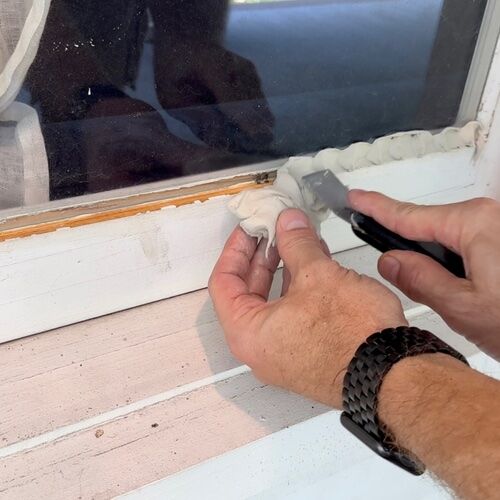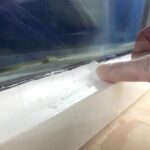Choosing the right material for sealing your windows can make a huge difference in your home’s energy efficiency, appearance, and even your comfort. Are you wondering whether window glazing putty or caulk is the better choice for your needs?
You’re not alone. Many homeowners face this exact dilemma, and getting it wrong can lead to drafts, higher energy bills, and even damage to your windows over time. Picture this: a perfectly sealed window that not only keeps your home cozy but also enhances its aesthetic appeal.
That’s what you can achieve by understanding the differences between window glazing putty and caulk. This knowledge empowers you to make informed decisions, ensuring your home remains protected and looks its best. Curious about which option will provide the best seal and last the longest? Ready to uncover the secrets of achieving professional-quality results on your own? Dive into this article, and discover everything you need to know to make the best choice for your windows.

Credit: legenday.com.cn
Comparison Overview
Choosing the right sealant for your windows can be confusing. Window glazing putty and caulk are two popular options. Both have unique benefits and specific uses. Understanding their differences helps in making an informed decision. Below is a comparison overview to guide you.
What Is Window Glazing Putty?
Window glazing putty is a dough-like substance. It seals glass panes into window frames. It is traditional and has been used for years. Putty offers a secure and flexible seal. It is ideal for older wooden windows. The material is easy to apply but requires some drying time. It is also paintable after it hardens.
What Is Caulk?
Caulk is a flexible material used for sealing joints. It’s available in tubes or cartridges. Caulk can be silicone, acrylic, or latex-based. It provides a quick seal for various surfaces. Caulk is often used for newer windows. It dries faster than putty and requires less maintenance. Some types are paintable, while others are not.
Durability And Longevity
Window glazing putty is known for its durability. It can last for many years if maintained well. Caulk, on the other hand, may need replacement sooner. Especially in high-movement areas, caulk can crack over time. Choose putty for long-term projects. Opt for caulk for easy and quick applications.
Ease Of Application
Applying window glazing putty requires some skill. The material needs to be kneaded before use. It can take time to perfect the application. Caulk is easier to apply with a caulking gun. It is suitable for DIY projects. The choice depends on your confidence and skill level.
Cost Considerations
Window glazing putty is generally affordable. The overall cost is lower for small projects. Caulk varies in price based on type and brand. Silicone caulks can be more expensive. Consider your budget and the project size. Both materials are cost-effective for different scenarios.
Window Glazing Putty
When it comes to preserving and enhancing the beauty of your windows, window glazing putty stands out as a classic choice. It’s a favorite among traditionalists and DIY enthusiasts alike. If you’ve ever admired the timeless charm of old-world windows, chances are glazing putty had a hand in it. Let’s dive into what makes it special.
Composition And Characteristics
Glazing putty is typically made from a blend of linseed oil and powdered chalk. This mix creates a smooth, pliable substance that easily fills gaps between the glass and the window frame. Its texture is reminiscent of modeling clay, allowing for easy manipulation.
Unlike caulk, glazing putty doesn’t dry out quickly. This slow curing process ensures a solid seal that adapts to minor movements in the window frame. Plus, it offers a traditional finish that blends seamlessly with wood and older architectural styles.
Application Process
The application of glazing putty is straightforward, but it requires patience. Start by rolling the putty into thin ropes and press them into the frame grooves. Use a putty knife to smooth it out and create a uniform seal.
Don’t rush. It takes a bit of practice to perfect the finish. But with every application, you’ll get better at achieving that professional look. Have you ever tried using glazing putty? Share your tips and tricks in the comments!
Durability And Longevity
One of the major advantages of glazing putty is its durability. Once cured, it can last for decades, resisting the harsh elements without cracking or peeling. This longevity is a boon for homeowners wanting a long-term solution.
Think about the historic buildings you’ve visited. They often maintain their original windows thanks to the enduring quality of glazing putty. Wouldn’t it be nice to have windows that withstand the test of time?
Cost Implications
Glazing putty is generally affordable, making it a cost-effective option for window maintenance. While the upfront cost is low, the long-term savings are significant due to reduced maintenance needs.
In comparison, caulk may need more frequent replacements. If budget is a concern, glazing putty offers a balance between initial expenditure and lasting value. Are you considering this for your next project?
Choosing the right material for your windows involves weighing various factors. Glazing putty might just be the traditional touch you need to enhance your home’s aesthetic and durability. What’s your favorite method for window maintenance?
Caulk For Window Sealing
When it comes to sealing your windows, caulk is a popular choice for many homeowners. It’s known for its versatility and ease of use, making it a go-to solution for preventing drafts and moisture infiltration. But not all caulks are created equal, and knowing the right type for your specific needs can make all the difference in achieving a well-sealed home.
Types And Formulations
There are various types of caulk available, each designed for different applications. Silicone caulk is highly flexible and waterproof, making it ideal for bathrooms and kitchens. On the other hand, acrylic latex caulk is paintable and perfect for areas where aesthetics matter, like window frames.
You might also come across butyl rubber caulk, which is great for outdoor use due to its durability. Selecting the right formulation is crucial for achieving the best results. Have you checked the compatibility of your chosen caulk with your window material?
Ease Of Use
One reason caulk is favored is its simplicity in application. Most caulks come in squeeze tubes or cartridges compatible with a caulking gun. Even if you’re a DIY novice, you can apply caulk with just a little practice.
Ensure the surface is clean and dry for optimal adhesion. A steady hand and a damp rag for smoothing can help you achieve a neat finish. Have you ever tried applying caulk? It might be easier than you think!
Weather Resistance
Weather conditions can greatly affect how long your window seal lasts. Silicone caulk stands out for its resistance to extreme temperatures and UV rays. This makes it an excellent choice for exterior applications.
Acrylic latex caulk, while less weather-resistant, is still a solid option for interior sealing. If you’re in an area with fluctuating climates, consider using caulk with enhanced weatherproof properties. What kind of weather challenges do your windows face?
Price Considerations
Caulk is generally affordable, but prices can vary based on type and quality. Silicone caulks tend to be more expensive due to their durability and flexibility. Acrylic latex caulks are more budget-friendly and still offer good performance for indoor projects.
It’s wise to invest a bit more if you’re sealing areas prone to high moisture or temperature changes. Would you prefer to save upfront or ensure long-lasting results? Balancing cost with quality can lead to a successful sealing project.
Choosing the right caulk can significantly impact your window sealing efforts. By understanding the types, ease of use, weather resistance, and pricing, you’ll be better equipped to make an informed decision. So, are you ready to seal those pesky gaps?
Performance Analysis
Choosing the right sealant for your windows is crucial. It impacts energy efficiency, durability, and maintenance. Window glazing putty and caulk are popular choices. Each has unique performance characteristics. Let’s analyze their effectiveness, resistance to elements, and maintenance needs.
Sealant Effectiveness
Window glazing putty offers a strong seal. It fills gaps in window frames well. Caulk provides a flexible seal. It adapts to small movements or shifts. Both materials prevent air and water leaks. The choice depends on the specific window type and size.
Resistance To Elements
Glazing putty resists weather changes effectively. It holds up in rain, wind, and sun. Caulk can resist moisture and UV rays. It is ideal for outdoor applications. Consider the climate and exposure levels. This ensures long-lasting protection.
Maintenance Needs
Putty requires occasional checks and repairs. It may need repainting to maintain appearance. Caulk is easier to maintain. It requires less frequent inspections. Regular checks ensure optimal performance. Choose based on your maintenance preferences.
Environmental Impact
Choosing between window glazing putty and caulk affects the environment differently. Glazing putty, made from natural materials, often has a lower environmental footprint. Caulk, while versatile, may contain chemicals that impact air quality. Understanding these differences helps in making eco-friendly decisions.
When choosing between window glazing putty and caulk, understanding their environmental impact can guide you towards a more eco-conscious decision. The materials you use in home improvements can affect the planet. By considering their eco-friendliness and sustainability, you can make choices that align with your values.Eco-friendliness
Window glazing putty is often made from natural ingredients such as linseed oil and chalk, making it a more environmentally friendly option. These materials are biodegradable, reducing their ecological footprint. Caulk, on the other hand, often contains synthetic materials, which may not break down easily. These materials can contribute to pollution if not disposed of properly. Have you considered how the production and disposal of these materials impact the environment?Sustainability
Natural putty is sustainable because its ingredients are renewable and sourced responsibly. The use of organic materials supports sustainable practices and reduces reliance on non-renewable resources. Synthetic caulks, while durable, can have a longer-lasting negative impact on the environment. They often require energy-intensive manufacturing processes. The choice between putty and caulk can influence your carbon footprint. Are you ready to choose a more sustainable option for your home improvements?Best Applications
Choosing between window glazing putty and caulk depends on the application. Each material has unique properties suitable for different uses. Understanding where each excels can save time and money.
Home Renovations
For home renovations, window glazing putty is ideal for older homes. It provides a traditional look that matches historical styles. Use it for wooden window frames. It offers flexibility and a clean finish.
Caulk is better for modern homes. It seals gaps efficiently and is easy to apply. Use it around window frames for a neat appearance. It is also ideal for preventing drafts and moisture.
Commercial Use
In commercial settings, caulk is often preferred. It offers quick application and rapid curing. This is crucial for businesses needing minimal disruption. Use caulk for sealing large glass panes in office buildings.
Window glazing putty can be useful for restoring historical buildings. It provides the authentic look required for preservation projects. It’s best for windows that need regular maintenance and care.
Pros And Cons
Choosing between window glazing putty and caulk can be confusing. Both have their unique benefits and drawbacks. Understanding the pros and cons of each helps make an informed decision. Let’s dive into the details.
Advantages Of Putty
Putty offers a classic look. Many homeowners appreciate its traditional appearance. It provides excellent adhesion to glass and wood. This makes it a reliable option for many years. Putty is also easy to shape. It allows for a smooth finish around window panes. Furthermore, it is cost-effective. This makes it an affordable option for many projects.
Disadvantages Of Putty
Putty takes time to dry. This can delay painting projects. It also requires regular maintenance. It may crack or harden over time. Additionally, it can be difficult to remove. This may lead to extra work during window replacements. Putty is not suitable for plastic or metal frames. It adheres best to wood and glass.
Benefits Of Caulk
Caulk is versatile. It works on various surfaces like wood, metal, and plastic. It dries quickly, allowing for faster project completion. Caulk also provides a neat, clean finish. It comes in various colors to match different frames. It’s resistant to moisture. This helps prevent water damage around windows.
Drawbacks Of Caulk
Caulk may not last as long as putty. It can shrink over time, leading to gaps. Reapplication might be necessary. Some types may not adhere well to certain surfaces. This limits their effectiveness in some cases. Caulk can also be more expensive. This might impact budget considerations for large projects.

Credit: thecraftsmanblog.com

Credit: www.aroskybuildcon.com
Frequently Asked Questions
What Is Window Glazing Putty Used For?
Window glazing putty seals glass panes. It provides a secure, weather-resistant barrier. Great for wooden windows.
How Does Caulk Differ From Putty?
Caulk is more versatile. Used for sealing gaps in various materials. It offers flexibility and water resistance.
Can You Paint Over Window Glazing Putty?
Yes, you can paint it. Wait until it dries completely. Choose compatible paint for best results.
Which Is Better For Weatherproofing, Putty Or Caulk?
Caulk is better for weatherproofing. It offers excellent sealing against moisture. Perfect for modern homes.
Is It Easy To Apply Window Glazing Putty?
Yes, it is easy. Clean the area first. Then, apply putty smoothly with a knife.
Conclusion
Choosing between window glazing putty and caulk depends on your needs. Putty offers a traditional look. It suits older windows well. Caulk provides a modern seal. It works best for quick repairs. Both options have benefits. Consider your project’s requirements.
Think about ease of use and durability. Each choice impacts insulation and appearance. Proper application is crucial for effectiveness. Evaluate your skill level and tools. Understanding these materials helps make informed decisions. Explore your options carefully. A well-sealed window enhances energy efficiency.
It keeps your home comfortable year-round.




